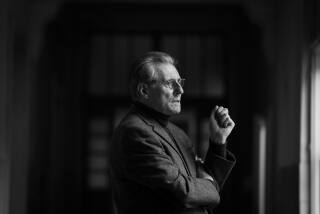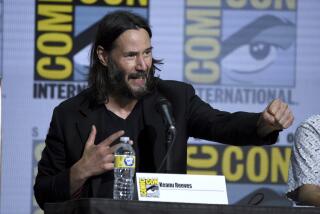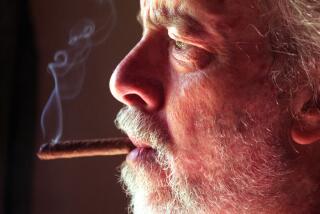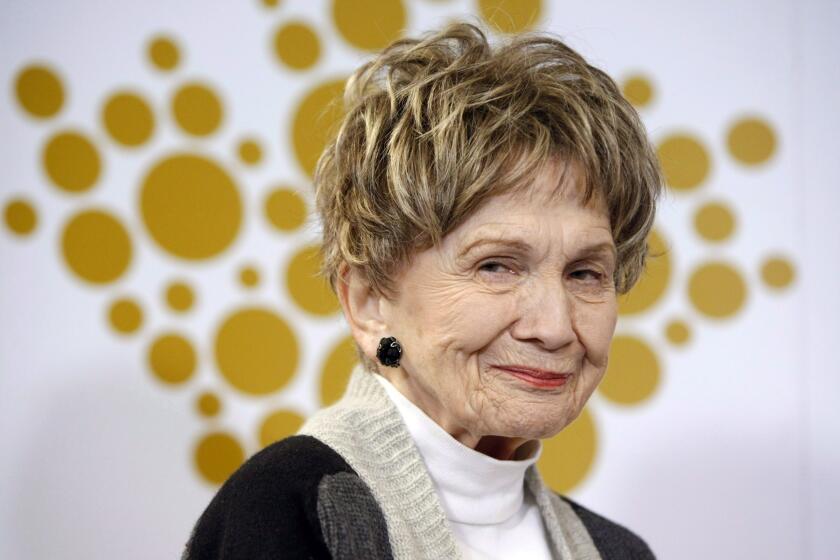Book review: ‘Nicholas Ray’ by Patrick McGilligan
Nicholas Ray faced a roomful of film students. They had come to learn from the director who’d made James Dean an icon in “Rebel Without a Cause” and a gunslinger of Joan Crawford in the distaff western “Johnny Guitar.” Ray began a mock exercise in filming a scene and the reverential students waited for his instructions — and they waited. Ray fell inexplicably silent. Minutes passed, then hours, and finally the students left, bewildered by the tall, frail man with an eye patch and wild, white hair.
Stories of an artist’s downfall occupy much of Patrick McGilligan’s “Nicholas Ray: The Glorious Failure of an American Director,” arriving for the filmmaker’s 100th birthday on Aug. 7. In 20-plus films ranging from workmanlike to brilliant, Ray demonstrated a compassion for flawed protagonists and a commitment to realism, from teen angst to Eskimo hunters. His work has been praised by European critics since the 1950s; now, McGilligan burnishes his legacy in America (where many of his best films remain unavailable on video), even while documenting in unsavory detail his implosion via drink and drugs.
Ray had a gift for personalizing his films even when they were hired-gun jobs. Early noirs and westerns, notably 1950’s “In a Lonely Place,” with Humphrey Bogart playing a writer accused of murder, and 1952’s “The Lusty Men,” starring Robert Mitchum as a displaced rodeo cowboy, show Ray’s empathy for desperate loners and outcasts. They are fitting metaphors for his own outsider status in Hollywood, where his sensitive persona never quite found its place.
By the time Ray became a film director in his 30s, he was a full-fledged bohemian trained by Thornton Wilder, Frank Lloyd Wright and Elia Kazan. He’d cut his teeth in New York’s leftist theater of the 1930s, lived in artist communes and traveled the backroads recording Woody Guthrie, Leadbelly and other folk artists for the Library of Congress. Most important, he’d become a protégé of producer John Houseman, who brought Ray to Hollywood.
“Rebel Without a Cause,” released in 1955, was his apex. The project had been in development for years, but Ray made it his own, a Shakespeare-sized tragedy set in teenage USA, where adults were the true delinquents. He hung out with street gangs in pursuit of authenticity and mentored Dean and 16-year-old Natalie Wood. His Chateau Marmont bungalow was alive with cast rehearsals and legendary parties.
“Rebel” is Ray’s masterpiece, a watershed moment in youth culture. But for Ray, the moment was short: Dean’s sudden death in a car crash wiped out plans for a film partnership, and Ray was never quite the same. He made a few more good films — the controversial “Bigger Than Life” with James Mason and the cult gangster flick “Party Girl” — but more mediocre ones. Stress and substance abuse mounted; Ray was fired off one picture, then collapsed while shooting 1963’s “55 Days at Peking,” his last. Its star Charlton Heston said that by now, Ray “wasn’t so much directing as acting the role of director.”
In a long, sad denouement, Ray taught at universities and filmed experimental shorts while living on booze and candy bars and crashing on friends’ couches, running up bar tabs and phone bills. The once-dashing young man became “The ghost of Beethoven,” as a friend described him. An innovative film collaboration with his students dragged on for years, unfinished. His final project, “Lightning Over Water,” was made with the great German director Wim Wenders, chronicling Ray’s 1979 death from cancer.
Parallels between Ray and fellow Hollywood outcast Orson Welles are occasionally drawn, but the analogy is thin: While Welles was the author of his own outsize tragedy, Ray could be quiet, sometimes receding into the background of his own story. Ray had traumas — among them, finding actress wife Gloria Grahame in bed with his 13-year-old son from a prior marriage — but it was difficult to tell what his demons were or why they destroyed him. His talent for lying didn’t help, either; many finer points of Ray’s life and work (even the truth about his lost right eye) remain frustratingly fuzzy.
Ray called himself “the best damn filmmaker in the world who has never made one entirely good, entirely satisfactory film.” McGilligan’s biography is similarly contradictory; it wants its subject to be accepted as a major postwar director but acknowledges in its very title that but for all the lasting influence Ray had on the Truffauts and Scorseses, he never quite made the cut.
Ryfle is co-writing a biography of film director Ishiro Honda to be published by Wesleyan University press.
More to Read
Sign up for our Book Club newsletter
Get the latest news, events and more from the Los Angeles Times Book Club, and help us get L.A. reading and talking.
You may occasionally receive promotional content from the Los Angeles Times.










